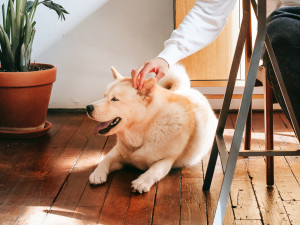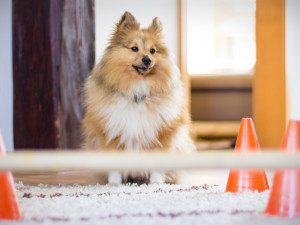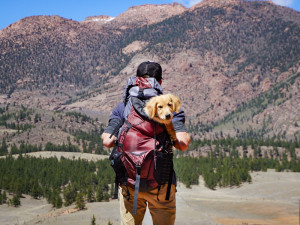10 Ways to Make Your Dog’s Life Better
Number 6 will probably surprise you.

share article

Your pet wants you to read our newsletter. (Then give them a treat.)
Pretty much every pet parent wants their pup to live their best life. You try (and get) to do it all for them — the indestructible chew toy, the new sweater for fall, the best vet in town. But what exactly can we do to increase our dog's happiness quotient? Here’s a short list of ways to exponentially improve the quality of our dogs’ lives.
1. Turn up the dial on the exercise meter.
Dogs adore activity — hence, the crazy exuberance most display at the very whisper of a “walk.” Taking your pup on an extra-long hikeopens in a new tab, joining you on a jog, or going on a few short outings in addition to those daily walks will be well received. Look for a place your dog can enjoy a safe off-leash run like a dog parkopens in a new tab, which will make the experience even more enjoyable for them.
2. Fight boredom.
Give your dog more mental stimulation with mind-engaging activities such as enrichment puzzlesopens in a new tab, new toys, visits to new places, and learning new skills and tricks.
3. Give them a hand.
Most dogs learn visual signals faster than verbal ones. When training, communicate more clearly by using hand signals along with words. Your dog will heave a figurative sigh of relief at finally being able to understand you.
4. Rub them the right way.
Most dogs, like most people, appreciate a good massageopens in a new tab. It not only promotes relaxation, healing and bonding, it feels sooooo good (you’ll know for sure when they’re back leg starts twitching).
5. Stop and smell the world.
Dogs need to be dogs, and that means allowing them time to explore the world’s wonderful (and not so wonderful) odors.opens in a new tab You can also try to engage them in scent work activities:. Using their noses comes naturally, so tracking or playing scent games is fun for dogs.
6. Free them from fashion.
Consider removing your dog’s collar at night. Dogs will probably enjoy the freedom just as much as we do when we take off our belts, watches or earrings. Plus, the noise of jingling tags bothers many dogs; to reduce it, tape the tags together or stow them in a pouch designed for that purpose.
7. Feed them well.
While the debate about canine nutrition rages, most people agree that a variety of food, especially if it’s healthy and freshopens in a new tab, has many advantages. Carefully consider what you feed your dog, do some research, and ask your veterinarian for help in making good choices.
8. Keep them tidy.
Good grooming is essential; dogs are most comfortable when their coats are orderly and free of any mats that tug uncomfortably at their skin. Abolishing tangles helps them eliminate more easily (aka no poop stuck in their fur!) and short toenails allow for easier movement comfortably. And no matter how darling your dog may look with fur hanging over the eyesopens in a new tab, or how popular that style is for the breed, a haircut that allows for unobstructed vision is a better (and safer) choice.
9. Play it up.
Make play dates for your dog with other nice, well-socialized pups. Most dogs love to play with other dogs, and their exhilaration is palpable as they frolic together.
10. Sharpen your focus.
Dogs value the time we spend focused completely on them, and that’s easiest to do without anyone else present. This quality time is especially valuable and important in multi-dog households. So carve out some one on one time for your pup every day to make their tail wag like crazy.

Karen B. London, PhD, CAAB, CPDT-KA
Karen B. London, Ph.D., is a Certified Applied Animal Behaviorist and Certified Professional Dog Trainer who specializes in working with dogs with serious behavioral issues, including aggression, and has also trained other animals including cats, birds, snakes, and insects. She writes the animal column for the Arizona Daily Sun and is an Adjunct Professor in the Department of Biological Sciences at Northern Arizona University. She is the author of six books about training and behavior, including her most recent, Treat Everyone Like a Dog: How a Dog Trainer’s World View Can Improve Your Lifeopens in a new tab.
Related articles
![Shetland sheepdog sits in front of a obstacle course for dogs in the living room]() opens in a new tab
opens in a new tab3 Fun Indoor Games to Play With Your Dog
Rainy day? These activities will keep your dog (and you!) from going stir crazy.
![Black dog running along the shore, towards Golden Gate Bridge, San Francisco, CA]() opens in a new tab
opens in a new tabDog-Friendly Must-Sees In San Francisco’s Presidio
This summer, explore these dog-friendly beaches and heavenly hikes.
![Man backpacking with his Golden Retriever puppy in a state park]() opens in a new tab
opens in a new tab51 Dog-Friendly Spots to Visit With Your Pup This Summer
Where to go and what to do — from Alabama to Wyoming.
![A young woman standing next to her bike with the dog in the basket]() opens in a new tab
opens in a new tabHow to Take Your Dog on a Bike Ride
How to take your dog for a spin — safely.




